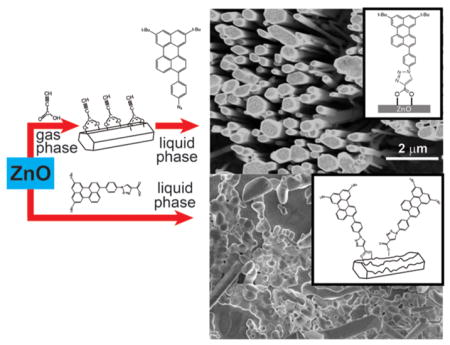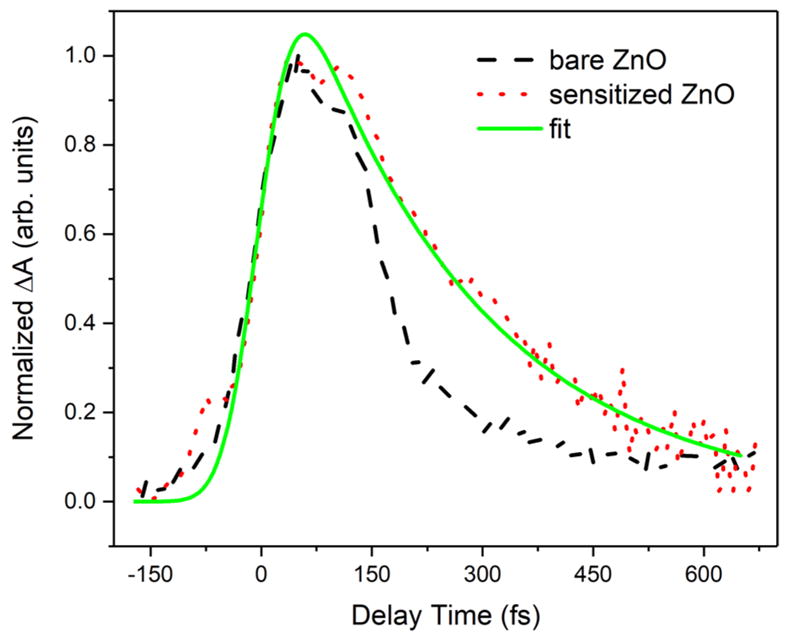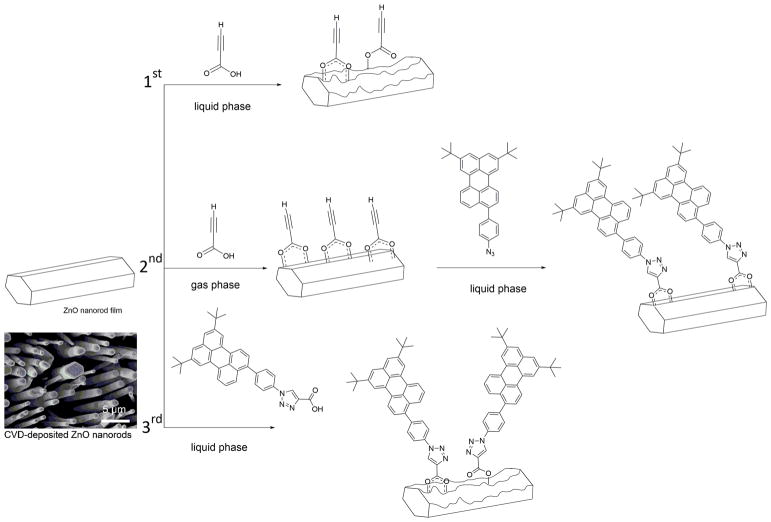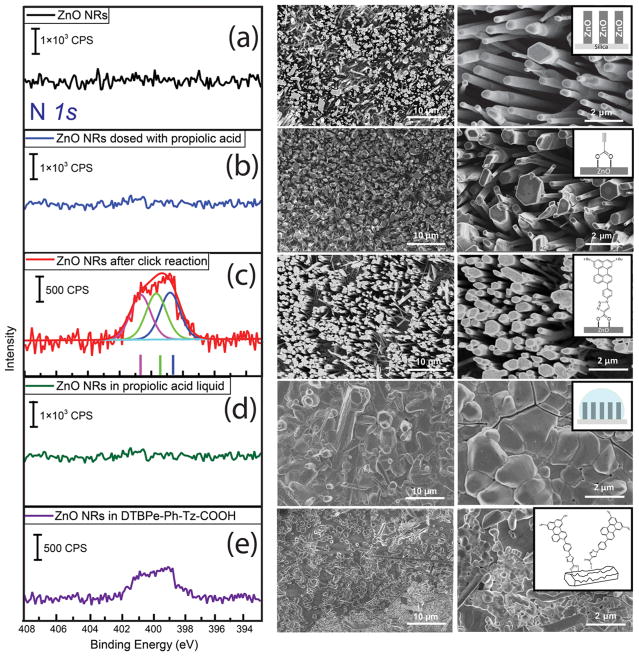Abstract
Films of ZnO nanorods grown by chemical vapor deposition were functionalized with a chromophore in a stepwise process that preserves the surface morphology. In the first step, the ZnO nanorods were functionalized by exposure to prop-2-ynoic acid (propiolic acid) in vacuum, which did bind through the COOH group leading to a ZnO surface functionalized with ethyne moieties (ethyne/ZnO). In the second step, 9-(4-azidophenyl)-2,5-di-tert-butylperylene (DTBPe-Ph-N3) was reacted with the ethyne/ZnO surface via copper-catalyzed azide–alkyne click reaction (CuAAC) in solution to form the DTBPe-functionalized surface (DTBPe/ZnO). The ZnO morphology was preserved after each step, as demonstrated by scanning electron microscopy (SEM). Each step was probed by X-ray photoelectron spectroscopy (XPS), and transient absorption spectroscopy (TA) of the resulting DTBPe/ZnO surface shows interfacial electron transfer following visible light excitation. As expected, attempts to bind the reference compound 1-(4-(8,11-ditert-butylperylen-3-yl)-phenyl)-1H-1,2,3-triazole-4-carboxylic acid (DTBPe-Ph-Tz-COOH) directly from solution lead to etched surfaces (confirmed by SEM) and undefined binding modes (confirmed by TA).
Graphical Abstract

Nanostructured wide band gap metal oxides (ZnO, TiO2, SnO2) are important components for applications involving environment and solar energy conversion. Covalent surface functionalization of metal oxide films with chromophoric organic and inorganic molecules (sensitization) extends the absorption of metal oxides into the visible spectral range, and allows sunlight-promoted processes. These are used for photocatalysis,1,2 photovoltaics,3 and photodegradation of chemicals for environmental remediation.4 In particular, their use as components for dye-sensitized solar-cells (DSSCs) and dye-sensitized photoelectrosynthesis cells (DSPECs) remains a vibrant field of research and technological progress.5 Finally, chromophore/metal oxide interfaces are important in fundamental studies of interfacial charge transfer processes.6
Surface sensitization with covalently attached dye-molecules requires a large surface area per volume that in most cases is provided by employing mesoporous, μm-thick films made of nanostructured metal oxides. These can have varying morphology, most commonly nanocolloids, nanotubes, and nanowires.7,8 TiO2 nanocolloidal films are by far the most frequently used metal-oxide substrates in fundamental research and practical applications. An important reason for the dominance of TiO2 is the inherent chemical stability of its surface, which is inert against strong acids at room temperature and requires extreme conditions for etching. Consequently, covalent modification from solutions by sensitizer molecules via carboxylic (COOH) or phosphonic (P(O)(OH)2) anchor groups is a standard practice.
ZnO has a similar band gap compared to TiO2 (3.2 eV), and has attracted considerable attention as a viable alternative to TiO2. ZnO can easily be grown as highly crystalline (wurtzite) and vertically aligned nanowires, and in a variety of other ordered morphologies.9 Also, ZnO nanorod or nanowire electrodes exhibit higher electron mobility, a property that is attractive for applications in solar energy conversion.10 However, ZnO is etched by the acidic anchor groups used to bind the sensitizers,11–14 resulting in the formation of zincate salts that may deposit onto the surface. The binding may be further complicated when multiple surface anchors are present on the same sensitizer. Strategies aiming to preserve the integrity of ZnO nanostructure surface include the development of ZnO materials alloyed with MgO (such as MgxZn1−xO). However, alloying requires metal organic chemical vapor deposition (MOCVD) methods, and affects the band gap properties.15 Additional stabilization strategies include preparation of different reconstructions of clean ZnO surfaces, which can only be achieved in vacuum,16 atomic layer deposition of thin layers of chemically inert aluminum oxide,17 and chemical stabilization of the surface with reagents such as alkylammonium alkylcarbamates, which may also influence surface structure and electronic properties.18
The liquid phase chemical modification of ZnO nanorods and nanostructures has been demonstrated either by one-step or two-step procedures. The one-step method involved exposure of the surface to solutions of the acidic dye molecule. In two-step procedures, the surface is initially functionalized with a molecule carrying an anchor group for binding and a second group for further reactivity, followed by a second modification step that is often based on nucleophilic substitution or, preferably, click chemistry.14,19 The use of click chemistry20–25 as the second step in ZnO modification is an important development, as it is a versatile and highly successful approach for surface functionalization. However, the fact that the first step is conducted in solution can lead to ZnO surface etching even in the most successful ZnO surface modification schemes.14
Building on a recent finding by the Teplyakov group,26 here we demonstrate a two-step process where, in the first step, the clean ZnO surface is functionalized and passivated by chemisorption of propiolic acid from the gas phase. This step results in a well-defined attachment of the COOH anchor group, with only a single type of surface carboxylate formed, as supported by the IR spectroscopy, XPS, and solid-state NMR studies.26 This leaves the ethyne unit ready to react via click chemistry, allowing subsequent attachment of sensitizers. More importantly, the gas phase functionalization in the first step preserves the surface morphology and protects the surface of the nanostructured ZnO material, so that the click reaction20–25 in the second step can be performed in either gas phase (by uncatalyzed thermal process) or in liquid phase (by CuAAC).
We applied this approach to modify ZnO nanorods with propiolic acid in the gas-phase followed by the copper-catalyzed click reaction (CuAAC) of the alkyne functionality with a specially synthesized azido-substituted perylene dye, 9-(4-azidophenyl)-2,5-di-tert-butylperylene (DTBPe-Ph-N3). A comparison was made by exposure to a solution (1 mM solution in THF) of the expected surface click product, 1-(4-(8,11-ditert-butylperylen-3-yl)-phenyl)-1H-1,2,3-triazole-4-carboxylic acid (DTBPe-Ph-Tz-COOH), which was synthesized independently. Figure 1 shows a scheme of the comparative study presented here. The first and third route, direct liquid phase functionalization with either the propiolic acid or DTBPe-Ph-Tz-COOH lead to surface etching and poorly defined binding. The center two-step procedure starting from gas-phase sensitization preserved surface morphology and resulted in well-defined binding.
Figure 1.
Schematic representation of the reaction pathways designed to functionalize ZnO nanostructures. If the first step is performed in liquid phase, additional complications may be caused by molecularly adsorbed carboxylic acids.26
Figure 2 shows XPS and SEM studies of key steps illustrated in Figure 1 and compares the three different procedures. The pristine ZnO nanorods are shown in Figure 2a. No surface nitrogen is observed, and the SEM shows a top view of the ZnO nanorods. This morphology is preserved after the gas-phase reaction with propiolic acid on the length scale of the SEM resolution (Figure 2b). Reaction of the resulting ethynefunctionalized surface with perylene azide in the presence of a Cu(I) catalyst (copper(I) acetate, 24 h, 40 °C under Ar atmosphere) in THF does not alter the surface morphology. In addition, XPS shows the presence of nitrogen (Figure 2c). Consistent with triazole formation, three different nitrogen peaks can be identified in Figure 2c, and this assignment is supported by the computational predictions as described below. By contrast, the solution reaction of pristine ZnO nanorod films with liquid propiolic acid at room temperature (1 mM, room temperature, THF, 30 min, followed by washing and drying procedure described in Supporting Information) resulted in severe etching, as shown in Figure 2d. Similarly, exposing pristine ZnO nanorods to DTBPe-Ph-Tz-COOH in solution (1 mM, room temperature, THF; see Supporting Information for a complete procedure), leads to surface etching (Figure 2e) as well. Importantly, despite the use of a dilute (1 mM) THF solution and short binding times (30 min), the majority of the ZnO nanorods were etched. It should be noted that these are binding conditions typically employed for solution sensitization. The morphology of the material is clearly altered by the standard procedure, but some of the nanostructures are still present on the surface following treatment, suggesting that some sensitizer molecules can be bound and can lead to erroneous results or incorrect interpretations in measurements, as demonstrated below.
Figure 2.
XPS spectra and SEM images of the chemical modification steps for ZnO nanorod functionalization. Each step is indicated in the left column: (a) pristine ZnO nanorods; (b) same material dosed with propiolic acid in the gas phase; (c) material in panel b reacted with 9-(4-azidophenyl)-2,5-di-tert-butylperylene via copper-catalyzed azide–alkyne click reaction (CuAAC) in solution (following washing and drying as described in Supporting Information); (d) pristine nanorods exposed to liquid phase propiolic acid (following washing and drying procedure described in Supporting Information); (e) ZnO nanorods exposed to a solution of 1-(4-(8,11-ditert-butylperylen-3-yl)-phenyl)-1H-1,2,3-triazole-4-carboxylic acid (following washing and drying as described in Supporting Information). The assignment of the color-coded features in panel c is performed based on DFT calculations, as described in Supporting Information.
One example of such misinterpretation can be inferred based on the N 1s XPS studies presented in Figure 2 for each of the surface modification steps. Clean ZnO nanorods or the same material exposed to the propiolic acid do not exhibit any signatures of nitrogen-containing species, as expected. The liquid phase attachment of DTBPe-Ph-N3 to the gas phase propiolic acid-prefunctionalized ZnO nanorods results in the signature of the triazole ring supported by the computational DFT investigations summarized in Figure 2c. This comparison is also supported by the previous studies of triazole ring formation.27–29 Direct exposure to a DTBPe-Ph-Tz-COOH solution also results in a similar N 1s signature (Figure 2e), although the intensity of the observed feature is much smaller compared to the spectrum in Figure 2c. In summary, chemical attachment or physisorption of DTBPe-Ph-Tz-COOH to ZnO nanorods does occur, but it is not obvious what the surface species formed in this case really are, since the reaction clearly results in a nearly complete destruction of the nanorods.
In order to address these concerns, a set of ultrafast measurements were performed and compared for the differently prepared samples. It is well-known that the photo-excitation of perylene dyes bound to TiO2 or ZnO leads to interfacial electron transfer into the semiconductor conduction band. For perylene-based sensitizers with similar anchor groups electron transfer times of around 100–200 fs have been observed.30,31 However, this ultrafast heterogeneous electron transfer (HET) relies on strong electronic coupling between sensitizer and semiconductor acceptor state that requires in general chemisorption on the surface. We applied pump/white-light probe transient absorption (TA) to measure the population dynamics of excited state and the formation of the cation. Figure 3 shows a proof-of-principle TA measurement of a ZnO/perylene dye system prepared via click-chemistry compared to the instantaneous response of bare ZnO. The excited state of perylene is known to show absorption above 700 nm.
Figure 3.

Comparison of excited state decay for bare ZnO (black dashed) and “click” sensitized ZnO (red dotted) together with a fit with a rate model (green solid).
Transients have been extracted from TA maps (shown in the Supporting Information) at 725 nm and are compared in Figure 3. Spectra were analyzed by fitting the data at specific wavelength to a set of rate equations corresponding to the observed dynamics. Signal analysis is described in detail elsewhere.30 It can be clearly seen that a long-lived contribution is present in the sensitized film that has a lifetime of about 200 fs. The spectral position agrees with that of the excited state of perylene and the lifetime (HET time) agrees well with those measured for perylene molecules with similar linkers.31 The rapid disappearance of the excited state signal indicates fast electron injection into ZnO and hence strong electronic coupling between the molecular donor state and the ZnO conduction band acceptor states. Weakly bound molecules, on the other hand, would show much slower HET and would result in a much slower decay of the signal. For comparison, the lifetime of the excited state in isolated perylene molecules is approximately 5 ns. These measurements show that the two-step gas-phase click synthesis results in strong electronic coupling between the molecule and the semiconductor.
TA measurements have also been performed on the etched surface (Figure 2e) that resulted from direct exposure to DTBPe-Ph-Tz-COOH. Transients at the excited state absorption wavelength show longer lived contributions (see Supporting Information) that are consistent with the XPS measurements in Figure 2e and can be assigned to the weakly bound residues on the etched film. This shows that XPS and TA alone can lead to results that are very similar for well-defined functionalized surfaces and badly etched surfaces and are prone to misinterpretation.
Thus, carefully designed chemical modification of ZnO nanostructures can yield identifiable responses and interpretable measurements of heterogeneous electron transfer. It must be emphasized that the interpretation of these measurements requires complete characterization of the systems studied in order to address the actual structures produced by surface modification. In other words, a combination of synthetic capabilities with appropriately designed surface functionalization schemes and spectroscopic and microscopic characterization is a prerequisite for reliable and useful measurements of HET, as was demonstrated in this work.
Supplementary Material
Acknowledgments
The work in the AVT group at the University of Delaware was partially supported by the National Science Foundation (DMR1609973 (GOALI)). A.V.T. acknowledges the support of NSF (9724307; 1428149) and the NIH NIGMS COBRE program (P30-GM110758) for research activities in the University of Delaware Surface Analysis Facility and W. M. Keck Center for Advanced Microscopy and Microanalysis. This material is based upon work supported by the U.S. Department of Energy, Office of Science, Office of Basic Energy Sciences, Office of Energy Research, under Award Numbers DESC0016288 (Gundlach) and DE-FG02-01ER15256 (Galoppini).
Footnotes
Notes
The authors declare no competing financial interest.
The Supporting Information is available free of charge on the ACS Publications website at DOI: 10.1021/acs.jpclett.7b03388.
Material preparation, experimental details, computational description, and transient absorption measurements (PDF)
References
- 1.Brennaman MK, Dillon RJ, Alibabaei L, Gish MK, Dares CJ, Ashford DL, House RL, Meyer GJ, Papanikolas JM, Meyer TJ. Finding the Way to Solar Fuels with Dye-Sensitized Photoelectrosynthesis Cells. J Am Chem Soc. 2016;138:13085–13102. doi: 10.1021/jacs.6b06466. [DOI] [PubMed] [Google Scholar]
- 2.Schneider J, Matsuoka M, Takeuchi M, Zhang J, Horiuchi Y, Anpo M, Bahnemann DW. Understanding TiO2 Photocatalysis: Mechanisms and Materials. Chem Rev. 2014;114:9919–9986. doi: 10.1021/cr5001892. [DOI] [PubMed] [Google Scholar]
- 3.Zhang Q, Dandeneau CS, Zhou X, Cao G. ZnO Nanostructures for Dye-Sensitized Solar Cells. Adv Mater. 2009;21:4087–4108. [Google Scholar]
- 4.Ong WJ, Tan LL, Chai SP, Yong ST, Mohamed AR. Facet-Dependent Photocatalytic Properties of TiO2-Based Composites for Energy Conversion and Environmental Remediation. ChemSusChem. 2014;7:690–719. doi: 10.1002/cssc.201300924. [DOI] [PubMed] [Google Scholar]
- 5.Anta JA, Guillén E, Tena-Zaera R. ZnO-Based Dye-Sensitized Solar Cells. J Phys Chem C. 2012;116:11413–11425. [Google Scholar]
- 6.Nieto-Pescador J, Abraham B, Gundlach L. Photoinduced Ultrafast Heterogeneous Electron Transfer at Molecule-Semiconductor Interfaces. J Phys Chem Lett. 2014;5:3498–3507. doi: 10.1021/jz501541a. [DOI] [PubMed] [Google Scholar]
- 7.Gonzalez-Valls I, Lira-Cantu M. Vertically-Aligned Nanostructures of ZnO for Excitonic Solar Cells: A Review. Energy Environ Sci. 2009;2:19–34. [Google Scholar]
- 8.Huss AS, Bierbaum A, Chitta R, Ceckanowicz DJ, Mann KR, Gladfelter WL, Blank DA. Tuning Electron Transfer Rates via Systematic Shifts in the Acceptor State Density Using Size-Selected ZnO Colloids. J Am Chem Soc. 2010;132:13963–13965. doi: 10.1021/ja104482t. [DOI] [PubMed] [Google Scholar]
- 9.Fan Z, Lu JG. Zinc Oxide Nanostructures: Synthesis and Properties. J Nanosci Nanotechnol. 2005;5:1561–1573. doi: 10.1166/jnn.2005.182. [DOI] [PubMed] [Google Scholar]
- 10.Devan RS, Patil RA, Lin JH, Ma YR. One-Dimensional Metal-Oxide Nanostructures: Recent Developments in Synthesis, Characterization, and Applications. Adv Funct Mater. 2012;22:3326–3370. [Google Scholar]
- 11.Keis K, Bauer C, Boschloo G, Hagfeldt A, Westermark K, Rensmo H, Siegbahn H. Nanostructured ZnO Electrodes for Dye-Sensitized Solar Cell Applications. J Photochem Photobiol, A. 2002;148:57–64. [Google Scholar]
- 12.Yang J, Lin Y, Meng Y. Effects of Dye Etching on the Morphology and Performance of ZnO Nanorod Dye-Sensitized Solar Cells. Korean J Chem Eng. 2013;30:2026–2029. [Google Scholar]
- 13.Yan F, Huang L, Zheng J, Huang J, Lin Z, Huang F, Wei M. Effect of Surface Etching on the Efficiency of ZnO-Based Dye-Sensitized Solar Cells. Langmuir. 2010;26:7153–7156. doi: 10.1021/la904238n. [DOI] [PubMed] [Google Scholar]
- 14.Bishop LM, Yeager JC, Chen X, Wheeler JN, Torelli MD, Benson MC, Burke SD, Pedersen JA, Hamers RJ. A Citric Acid-Derived Ligand for Modular Functionalization of Metal Oxide Surfaces Via “Click” Chemistry. Langmuir. 2012;28:1322–1329. doi: 10.1021/la204145t. [DOI] [PubMed] [Google Scholar]
- 15.Brenner TM, Flores TA, Ndione PF, Meinig EP, Chen G, Olson DC, Furtak TE, Collins RT. Etch-Resistant Zn1−xMgxO Alloys: An Alternative to ZnO for Carboxylic Acid Surface Modification. J Phys Chem C. 2014;118:12599–12607. [Google Scholar]
- 16.Torbrügge S, Ostendorf F, Reichling M. Stabilization of Zinc-Terminated ZnO (0001) by a Modified Surface Stoichiometry. J Phys Chem C. 2009;113:4909–4914. [Google Scholar]
- 17.Law M, Greene LE, Radenovic A, Kuykendall T, Liphardt J, Yang P. ZnO-Al2O3 and ZnO-TiO2 Core-Shell Nanowire Dye-Sensitized Solar Cells. J Phys Chem B. 2006;110:22652–22663. doi: 10.1021/jp0648644. [DOI] [PubMed] [Google Scholar]
- 18.Luo B, Rossini JE, Gladfelter WL. Zinc Oxide Nanocrystals Stabilized by Alkylammonium Alkylcarbamates. Langmuir. 2009;25:13133–13141. doi: 10.1021/la901830n. [DOI] [PubMed] [Google Scholar]
- 19.Cardiel AC, Benson MC, Bishop LM, Louis KM, Yeager JC, Tan Y, Hamers RJ. Chemically Directed Assembly of Photoactive Metal Oxide Nanoparticle Heterojunctions via the Copper-Catalyzed Azide-Alkyne Cycloaddition “Click” Reaction. ACS Nano. 2012;6:310–318. doi: 10.1021/nn203585r. [DOI] [PubMed] [Google Scholar]
- 20.Rostovtsev VV, Green LG, Fokin VV, Sharpless KB. A Stepwise Huisgen Cycloaddition Process: Copper(I)-Catalyzed Regioselective “Ligation” of Azides and Terminal Alkynes. Angew Chem, Int Ed. 2002;41:2596–2599. doi: 10.1002/1521-3773(20020715)41:14<2596::AID-ANIE2596>3.0.CO;2-4. [DOI] [PubMed] [Google Scholar]
- 21.Meldal M, Tornøe CW. Cu-Catalyzed Azide - Alkyne Cycloaddition. Chem Rev. 2008;108:2952–3015. doi: 10.1021/cr0783479. [DOI] [PubMed] [Google Scholar]
- 22.Xi W, Scott TF, Kloxin CJ, Bowman CN. Click Chemistry in Materials Science. Adv Funct Mater. 2014;24:2572–2590. [Google Scholar]
- 23.Devaraj NK, Collman JP. Copper Catalyzed Azide-Alkyne Cycloadditions on Solid Surfaces: Applications and Future Directions. QSAR Comb Sci. 2007;26:1253–1260. [Google Scholar]
- 24.Arumugam S, Orski SV, Mbua NE, McNitt C, Boons GJ, Locklin J, Popik VV. Photo-Click Chemistry Strategies for Spatiotemporal Control of Metal-Free Ligation, Labeling, and Surface Derivatization. Pure Appl Chem. 2013;85:1499–1513. [Google Scholar]
- 25.Wong CH, Zimmerman SC. Orthogonality in Organic, Polymer, and Supramolecular Chemistry: From Merrifield to Click Chemistry. Chem Commun. 2013;49:1679–1695. doi: 10.1039/c2cc37316e. [DOI] [PubMed] [Google Scholar]
- 26.Gao F, Aminane S, Bai S, Teplyakov AV. Chemical Protection of Material Morphology: Robust and Gentle Gas-Phase Surface Functionalization of ZnO with Propiolic Acid. Chem Mater. 2017;29:4063–4071. doi: 10.1021/acs.chemmater.7b00747. [DOI] [PMC free article] [PubMed] [Google Scholar]
- 27.Liu Y, Williams MG, Miller TJ, Teplyakov AV. Nanoparticle Layer Deposition for Highly Controlled Multilayer Formation Based on High-Coverage Monolayers of Nanoparticles. Thin Solid Films. 2016;598:16–24. doi: 10.1016/j.tsf.2015.11.082. [DOI] [PMC free article] [PubMed] [Google Scholar]
- 28.Williams MG, Teplyakov AV. Building High-Coverage Monolayers of Covalently Bound Magnetic Nanoparticles. Appl Surf Sci. 2016;388:461–467. doi: 10.1016/j.apsusc.2015.11.212. [DOI] [PMC free article] [PubMed] [Google Scholar]
- 29.Zhao J, Gao F, Pujari SP, Zuilhof H, Teplyakov A. Universal Calibration of Computationally Predicted N 1s Binding Energies for Interpretation of XPS Experimental Measurements. Langmuir. 2017;33:10792–10799. doi: 10.1021/acs.langmuir.7b02301. [DOI] [PMC free article] [PubMed] [Google Scholar]
- 30.Nieto-Pescador J, Abraham B, Li J, Batarseh A, Bartynski RA, Galoppini E, Gundlach L. Heterogeneous Electron-Transfer Dynamics through Dipole-Bridge Groups. J Phys Chem C. 2016;120:48–55. doi: 10.1021/acs.jpcc.5b09463. [DOI] [PMC free article] [PubMed] [Google Scholar]
- 31.Gundlach L, Ernstorfer R, Willig F. Pathway-Dependent Electron Transfer for Rod-Shaped Perylene-Derived Molecules Adsorbed in Nanometer-Size TiO2 Cavities. J Phys Chem C. 2007;111:13586–13594. [Google Scholar]
Associated Data
This section collects any data citations, data availability statements, or supplementary materials included in this article.




